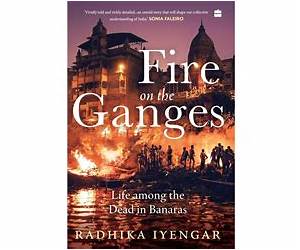Fire on the Ganges: Life among the Dead in Banaras By Radhika Iyengar
There must be some moral parable to be drawn from the fact that the Ganges is India s holiest river but also its most polluted Here by the ghats in Varanasi people dip underwater to cleanse themselves of their sins there round the bend of the river others are literally relieving themselves into the water Instead of fish the Ganges here is full of heavy metals industrial waste and hazardous chemicals and it has than four hundred times the acceptable levels of faecal coliform bacteria You don t need to look that up to know it s nothing good While filming here I dipped my GoPro into the river and let s just say I saw things I didn t want to see. And that of course is before you get to what s known euphemistically as human remains If Varanasi is famous for anything it s for the burning ghats where devout Hindus are cremated on the banks of the river thus earning themselves it s believed a fast track to moksha and escape from the cycle of reincarnation In general Hindus are not cremated after sunset but here at the ghats the burnings go on 24 7 In theory the bodies are burned to ash which is raked into the holy river but it s not always that thorough particularly during Covid when the pyres were overloaded and many locals have stories of bumping into a half burnt leg or other limb while out on the water. Those responsible for the sacred if unenviable task of burning the bodies belong to a sub caste called the Doms Just as the Ganges is both holy and polluted so the Doms are both revered and despised They are held to guard the holy fire which gives burnings here their sacramental efficacy but they are also at the bottom of India s caste system and considered by many upper caste Indians as untouchable. I didn t know anything about the Doms and it seems that a lot of Indians don t know all that much about them either Radhika Iyengar a writer who s come through Columbia s Graduate School of Journalism has spent a lot of time in the community to produce this eye opening book about their daily life not just the men dealing with back breaking labour and the dangers of heat and smoke inhalation at the ghats but also their families and the struggles of poverty education health and other quotidian battles that are faced by all the Doms in Varanasi This is not a work of investigative journalism Iyengar says in an afterword but I think she s being too diffident It may not be an investigation into a particular crime or injustice but it s a thoroughgoing work of social investigation As a jaded old hack it makes me extremely happy to read something like this that s clearly based on so much time spent just talking to people and sharing their lives the interviews that make up the bulk of the book stretch from 2015 right up to 2023 and represent an impressive investment of time and thought. And it pays off You get to know the dozen or so characters she concentrates on in intimate and often heartbreaking detail Her prose is sometimes a little purple even in the context of Indian English which can seem a little idiosyncratic to outsiders but she s very good where it counts She stays neutral in relating the facts but doesn t shy away from letting the story come out against the patriarchalism and casteism that plague her subjects I was really moved by it. As I was spending some time in Varanasi this kind of window into life here seemed completely engrossing Perhaps for others this doesn t quite have a broader general appeal but I think anyone interested in Indian society or social history widely should find plenty here to hold their attention Pack a copy on your next trip to India s holiest city but perhaps leave the swimsuit at home Radhika Iyengar
| Fire on the Ganges: Life among the Dead in Banaras By Radhika Iyengar |
| 9789356994676 |
| English |
| 352 |
| Hardcover |
 .
.